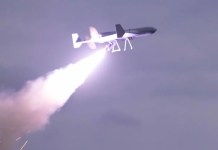The United States currently leads the race in the development of the most competent fighter jets on the face of the planet, boasting the likes of the stealthy pair of F-35 Lightning II and F-22 Raptors ably supported by F-16s and F-15 Eagles.
However, with the Pentagon now focusing their energies on the development of the secretive sixth-generation fighter jet, a prototype of which was tested last month, the US Navy has suggested it wants no part in it and would rather devote their resources elsewhere.
The recent developments come as a surprise with the US Navy initially invested in finding a replacement for their current fleet of McDonnell Douglas F/A-18 Hornets, to build a superior sixth-generation fighter to fly alongside the current serving Lockheed Martin F-35s.

Work had already been underway on the Navy’s Next-Generation Air Dominance (NGAD) program, under which it had begun analyzing airframes, targeting systems, artificial-intelligence-enabled sensors, new weapons and engine technologies in a bid to engineer a next-generation carrier-launched fighter jet.
However, as reported by Sputnik, the US Navy has now decided to scrap those plans, with Chief of Naval Operations (CNO) Admiral Michael Gilday stating that the US military does not want to invest in a program similar to the F-35 Fighter-Jet Program due to its extravagant costs and nature of long delays.
While commenting on any potential plans of going ahead with the ambitious sixth-generation fighter jet, Gilday said to Defence One State of the Navy podcast – “The F-35A flew around 2000 – That’s a whole generation (ago),”
We can’t wait till 2045 or 2050 if we’re going to make the investment in the multiple billions (of dollars). We don’t have time to wait or money to waste”
Why US-India ‘BECA’ Pact Can Douse Border Fire With China But Engulf Pakistan In Flames?
According to reports last month, the US Air Force secretly built and flew a prototype of the next-generation fighter jet which had been designed and developed as part of the NGAD program.
According to experts, the next-generation fighter jet will surpass the functionalities of the already existing-fleets of fifth-generation aircraft and could be equipped with laser weapons and a list of other state-of-the-art features.
However, Gilday states that the Navy would rather channel their resources elsewhere with the F-35s still proving to be an expensive and problem-plagued fighter jet.
“My job is to maximise naval power. We are making a lot of cuts to put money in shipbuilding. I can’t be buying stuff just to buy it.” said Gilday.
The trillion-dollar F-35 program despite its overall success in providing fighters which are considered the most sought after fighter jets in the world has been notoriously mismanaged with over-the-top costs and long-delays in production.
The F-35 program was undertaken by the United States Air Force as a means to replace the F-22 Raptor stealth fighters, who due to their speed, high maneuverability, and stealth features still reign as top air-superiority fighters.
The US Air Force figured that the F-35s would trump the Raptors in ground-attack roles, while also filling in for the needs of the Navy and the Marines for a multirole stealth fighter, which will eventually replace the F-15, F-16, FA-18 Hornets and AV-8 Harriers.
However, the single-seat fighters have continued to face major complications putting the pilot’s life in danger while also jeopardising combat missions.
According to Defence News, the fighter jets have been plagued with 13 severe technical deficiencies during its operational testing which included spikes in cabin pressure, some rare instances of structural damage at supersonic speeds and unpredictability while conducting extreme manoeuvres.
Moreover, unlike the Raptors, the F-35 fighters were considered to more affordable stealth fighters, which could be marketed to allies, but just like everything else, that has not gone according to the plan and thereby stand as an example for the Navy in its reluctance on developing a sixth-generation fighter jet which is bound to need even more capital and time.




